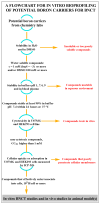Early Stage In Vitro Bioprofiling of Potential Low-Molecular-Weight Organoboron Compounds for Boron Neutron Capture Therapy (BNCT)-Proposal for a Guide
- PMID: 38786022
- PMCID: PMC11119693
- DOI: 10.3390/cells13100798
Early Stage In Vitro Bioprofiling of Potential Low-Molecular-Weight Organoboron Compounds for Boron Neutron Capture Therapy (BNCT)-Proposal for a Guide
Abstract
Given the renewed interest in boron neutron capture therapy (BNCT) and the intensified search for improved boron carriers, as well as the difficulties of coherently comparing the carriers described so far, it seems necessary to define a basic set of assays and standardized methods to be used in the early stages of boron carrier development in vitro. The selection of assays and corresponding methods is based on the practical experience of the authors and is certainly not exhaustive, but open to discussion. The proposed tests/characteristics: Solubility, lipophilicity, stability, cytotoxicity, and cellular uptake apply to both low molecular weight (up to 500 Da) and high molecular weight (5000 Da and more) boron carriers. However, the specific methods have been selected primarily for low molecular weight boron carriers; in the case of high molecular weight compounds, some of the methods may need to be adapted.
Keywords: BNCT; bioprofiling; boron carriers; drug development; in vitro methods; pre-clinical testing.
Conflict of interest statement
The authors declare no conflicts of interest.
Figures
References
-
- Sauerwein W. Principles and roots of neutron capture therapy. In: Sauerwein W., Wittig A., Moss R., Nakagawa Y., editors. Neutron Capture Therapy. Principles and Applications. Springer; Berlin/Heidelberg, Germany: New York, NY, USA: Dordrecht, The Netherlands: London, UK: 2012. pp. 1–16. - DOI
-
- IAEA: Advances in Boron Neutron Capture Therapy. International Atomic Energy Agency; Vienna, Austria: 2023.
-
- Kumada H., Sakae T., Sakurai H. Current development status of accelerator-based neutron source for boron neutron capture therapy. EPJ Tech. Instrum. 2023;10:18. doi: 10.1140/epjti/s40485-023-00105-5. - DOI
-
- Howell N., Middleton R.J., Sierro F., Wyatt N.A., Chacon A., HFraser B.H., Bambery K., Livio E., Dobie C., Bevitt J.J., et al. Neutron capture enhances dose and reduces cancer cell viability in and out of beam during helium and carbon ion therapy. Int. J. Radiat. Oncol. Biol. Phys. 2024 doi: 10.1016/j.ijrobp.2024.02.052. accepted . - DOI - PubMed
Publication types
MeSH terms
Substances
Grants and funding
LinkOut - more resources
Full Text Sources


